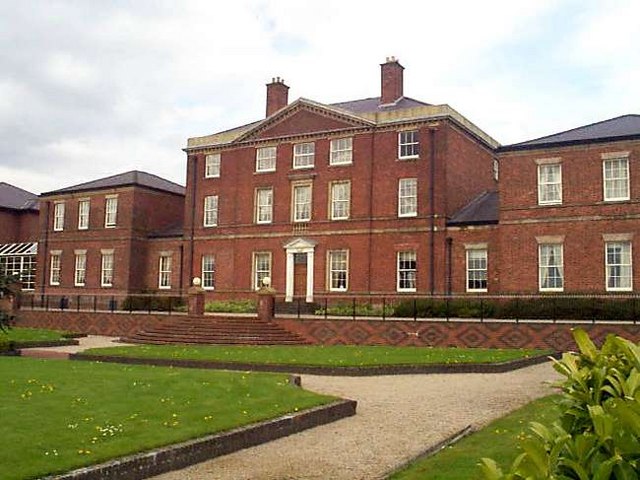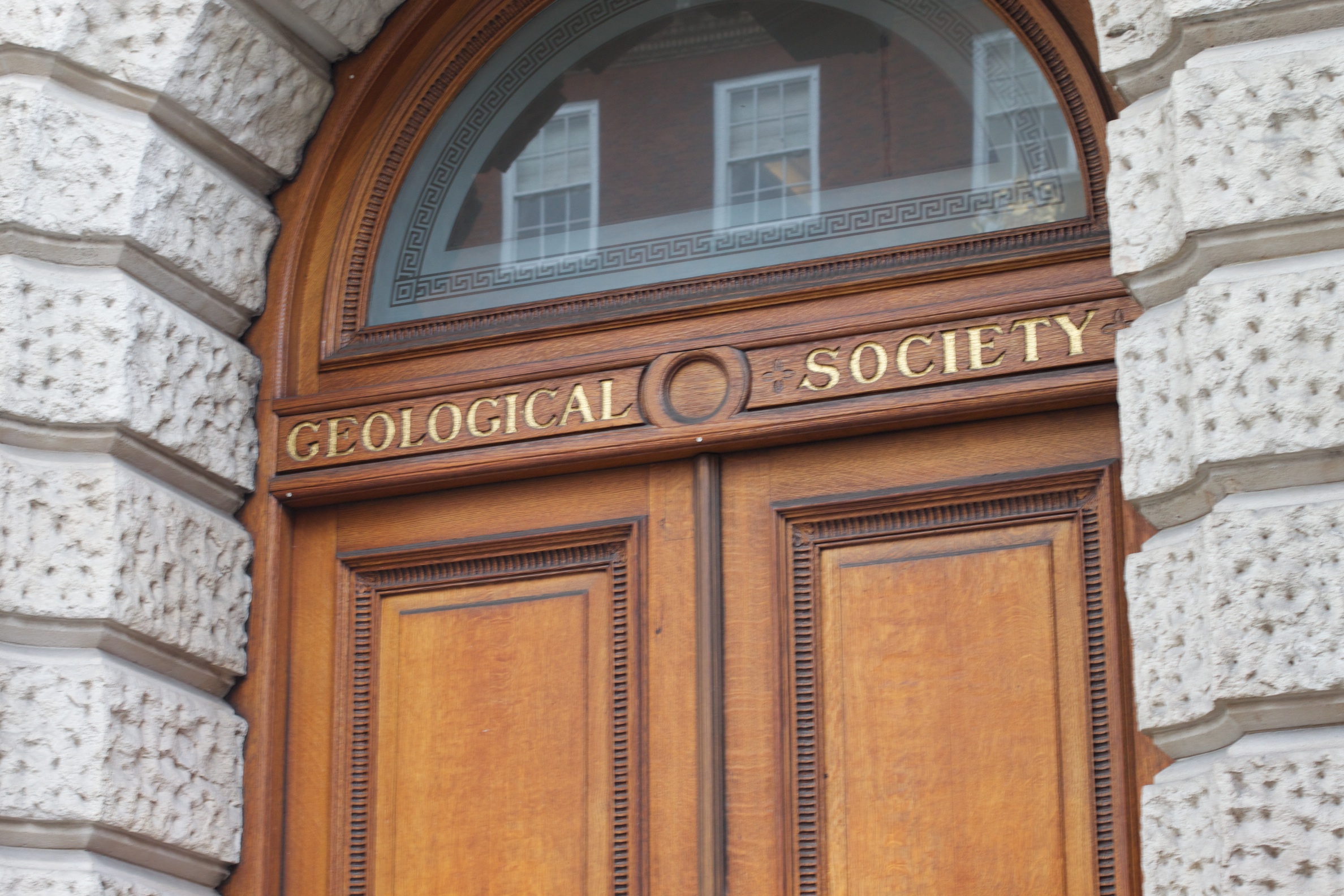|
Maer Hall
upright=1.35, Maer Hall Maer Hall is a large Grade II listed 17th-century country house in Maer, Staffordshire. The large stone-built country house and estate of Maer Hall dominates the village of Maer. Its location in the district of Newcastle-under-Lyme, Staffordshire, England, is attractively rural, but fairly close to the pottery manufacturing area around Stoke-on-Trent which attracted its most famous owner Josiah Wedgwood II. His nephew Charles Darwin often visited Maer, and married Josiah's daughter Emma. A manor house at Maer dates back to 1282, the owner then being William de Mere. The present stone house was built around 1680 on a slope above a small lake, or " mere", which gave the house its name. In the 18th century the landscape designer Capability Brown altered the lake in a scheme of pleasure grounds. The house could be approached from either the north entrance with its grade II listed lodge, or from the village of Maer to the south with its grade II* listed gateho ... [...More Info...] [...Related Items...] OR: [Wikipedia] [Google] [Baidu] |
Maer Hall - Geograph
{{disambig, geo, given name, surname ...
Maer may refer to: Places in the UK * Maer, Cornwall ** Maer Lake * Maer, Staffordshire ** Maer Hall, home of the pottery manufacturer Josiah Wedgwood II People * Matthew Maer, British Army officer * Maer Roshan (born 1967), Iranian-born American writer, editor, and entrepreneur Other uses * Maer (office), an administrative position in medieval Wales, Scotland, and Ireland * Maer (band), a group featuring Anna Murphy and Marjana Semkina See also * Maera (other) * Mare (other) * Marea (other) * Mayer (other) Mayer may refer to: * Mayer (name) Places * C. Mayer (crater), named after Christian Mayer * Mayer, Syria * Mayer, Arizona, United States * Mayer, Minnesota, United States * Mayersville, Mississippi, United States * Mayerthorpe, Alberta, Canada ... [...More Info...] [...Related Items...] OR: [Wikipedia] [Google] [Baidu] |
Etruria, Staffordshire
Etruria is a suburb of Stoke-on-Trent, Staffordshire, England. History Home of Wedgwood Etruria was the fourth and penultimate site for the Wedgwood pottery business. Josiah Wedgwood, who was previously based in Burslem, opened his new works in 1769. It was named after the Italian district of Etruria, home of the Etruscan people who were renowned for their artistic products. The site covered and was next to the Trent and Mersey Canal. As well as Wedgwood's home, Etruria Hall, it included the Etruria Works which remained in use by the Wedgwood enterprise until 1950. The Wedgwood factory is now in Barlaston, a village about six miles to the south of the Etruria site. Etruria Hall was the site of the substantial invention of photography by Thomas Wedgwood in the 1790s. After Wedgwood Much of Etruria became derelict with the move of Wedgwood after the Second World War and the subsequent closure of the nearby Shelton Bar steelworks. Large-scale regeneration began in th ... [...More Info...] [...Related Items...] OR: [Wikipedia] [Google] [Baidu] |
Country Houses In Staffordshire
A country is a distinct part of the world, such as a state, nation, or other political entity. It may be a sovereign state or make up one part of a larger state. For example, the country of Japan is an independent, sovereign state, while the country of Wales is a component of a multi-part sovereign state, the United Kingdom. A country may be a historically sovereign area (such as Korea), a currently sovereign territory with a unified government (such as Senegal), or a non-sovereign geographic region associated with certain distinct political, ethnic, or cultural characteristics (such as the Basque Country). The definition and usage of the word "country" is flexible and has changed over time. ''The Economist'' wrote in 2010 that "any attempt to find a clear definition of a country soon runs into a thicket of exceptions and anomalies." Most sovereign states, but not all countries, are members of the United Nations. The largest country by area is Russia, while the smallest is ... [...More Info...] [...Related Items...] OR: [Wikipedia] [Google] [Baidu] |
Listed Buildings In Maer, Staffordshire
Maer is a civil parish in the district of Newcastle-under-Lyme, Staffordshire, England. It contains 27 buildings that are recorded in the National Heritage List for England. Of these, three are listed at Grade II*, the middle of the three grades, and the others are at Grade II, the lowest grade. The parish contains the villages of Maer and Aston, and the surrounding countryside. Most of the listed buildings are houses, cottages, farmhouses and farm buildings. In the parish is a country house, Maer Hall upright=1.35, Maer Hall Maer Hall is a large Grade II listed 17th-century country house in Maer, Staffordshire. The large stone-built country house and estate of Maer Hall dominates the village of Maer. Its location in the district of Newcastle- ..., and another large house, Lea Head Manor, both of which are listed, together with associated structures. The other listed buildings are a church, memorials in the churchyard, and five mileposts. __NOTOC__ Key Buil ... [...More Info...] [...Related Items...] OR: [Wikipedia] [Google] [Baidu] |
Harrison Line
Harrison Line, officially ''T&J Harrison'', was a shipping line founded by the brothers Thomas and James Harrison in Liverpool, England in 1853. It ran both cargo and passenger services, starting with the import of French brandy from Charente. The ships were grouped under the Charente Steam-ship Company in 1871 with Thomas and James Harrison as the managers. The company ceased trading in October 2000, with all remaining rights and privileges transferred to P&O Nedlloyd. Early history Thomas and James Harrison moved from the family farm in Cockerham, Lancashire, to the port of Liverpool to join the thriving shipping trade. Both were apprenticed to the shipping agent Samuel Brown and Son, Thomas in 1830 and James in 1838. Thomas was made a partner in 1839 and the name of the firm was changed to George Brown and Harrison (George was Samuel’s son). James Harrison was made a partner in 1849. Closely involved with Samuel Brown, and integral to the development of the Liverpool firm, ... [...More Info...] [...Related Items...] OR: [Wikipedia] [Google] [Baidu] |
Davenport Pottery
Davenport Pottery was an English earthenware and porcelain manufacturer based in Longport, Staffordshire. It was in business, owned and run by the Davenport family, between 1794 and 1887, making mostly tablewares in the main types of Staffordshire pottery. History In 1785, John Davenport began as a potter working with Thomas Wolfe of Stoke. In 1794, he acquired his own pottery at Longport and began producing cream-coloured blue and white transfer-printed earthenware. In 1801 he began making glass, and by 1805 he was making porcelain and stone china as well. By September 1806 the quality of his porcelain wares was such that the Prince of Wales, later to become King George IV, ordered services of the finest and most valuable kinds. John retired in 1830 and his sons, William and Henry, carried on the firm. Henry died in 1835 and the firm became William Davenport and Company. William died in 1869. The firm continued under William’s two sons till 1887 when the factory was clo ... [...More Info...] [...Related Items...] OR: [Wikipedia] [Google] [Baidu] |
Geological Society Of London
The Geological Society of London, known commonly as the Geological Society, is a learned society based in the United Kingdom. It is the oldest national geological society in the world and the largest in Europe with more than 12,000 Fellows. Fellows are entitled to the postnominal FGS (Fellow of the Geological Society), over 2,000 of whom are Chartered Geologists (CGeol). The Society is a Registered Charity, No. 210161. It is also a member of the Science Council, and is licensed to award Chartered Scientist to qualifying members. The mission of the society is: "Making geologists acquainted with each other, stimulating their zeal, inducing them to adopt one nomenclature, facilitating the communication of new facts and ascertaining what is known in their science and what remains to be discovered". History The Society was founded on 13 November 1807 at the Freemasons' Tavern, Great Queen Street, in the Covent Garden district of London. It was partly the outcome of a previous ... [...More Info...] [...Related Items...] OR: [Wikipedia] [Google] [Baidu] |
Earthworm
An earthworm is a terrestrial invertebrate that belongs to the phylum Annelida. They exhibit a tube-within-a-tube body plan; they are externally segmented with corresponding internal segmentation; and they usually have setae on all segments. They occur worldwide where soil, water, and temperature allow. Earthworms are commonly found in soil, eating a wide variety of organic matter. This organic matter includes plant matter, living protozoa, rotifers, nematodes, bacteria, fungi, and other microorganisms. An earthworm's digestive system runs the length of its body. An earthworm respires (breathes) through its skin. It has a double transport system made of coelomic fluid that moves within the fluid-filled coelom and a simple, closed circulatory system. It has a central and peripheral nervous system. Its central nervous system consists of two ganglia above the mouth, one on either side, connected to a nerve running along its length to motor neurons and sensory cells in e ... [...More Info...] [...Related Items...] OR: [Wikipedia] [Google] [Baidu] |
Inception Of Darwin's Theory
The inception of Darwin's theory occurred during an intensively busy period which began when Charles Darwin returned from the survey voyage of the ''Beagle'', with his reputation as a fossil collector and geologist already established. He was given an allowance from his father to become a gentleman naturalist rather than a clergyman, and his first tasks were to find suitable experts to describe his collections, write out his '' Journal and Remarks'', and present papers on his findings to the Geological Society of London. At Darwin's geological début, the anatomist Richard Owen's reports on the fossils showed that extinct species were related to current species in the same locality, and the ornithologist John Gould showed that bird specimens from the Galápagos Islands were of distinct species related to places, not just varieties. These points convinced Darwin that transmutation of species must be occurring, and in his ''Red Notebook'' he jotted down his first evolutionary ideas ... [...More Info...] [...Related Items...] OR: [Wikipedia] [Google] [Baidu] |
John Webb (landscape Designer)
John Webb (1754–1828) was an English landscape designer, who also trained as an architect. He studied under William Emes between 1782 and 1793, and then established his own practice. He worked mainly in the Midlands and the north of England. In Staffordshire he was commissioned by Josiah Wedgwood to work in the gardens of Lowther Hall and Maer Hall. In Cheshire he designed work in the gardens of Rode Hall, Tabley House, Crewe Hall Crewe Hall is a Jacobean mansion located near Crewe Green, east of Crewe, in Cheshire, England. Described by Nikolaus Pevsner as one of the two finest Jacobean houses in Cheshire,Pevsner & Hubbard, p. 22 it is listed at grade I. Built in 1 ..., Tatton Park, and Ardene Hall. He followed Emes at Eaton Hall where he added new terrace walls, improved one of the approach roads by levelling it and planting 130,000 trees along it, and built a lake in the grounds. References Citations Sources * External linksCountry houses by John ... [...More Info...] [...Related Items...] OR: [Wikipedia] [Google] [Baidu] |
Robert Waring Darwin
Robert Waring Darwin (30 May 1766 – 13 November 1848) was an English medical doctor, who today is best known as the father of the naturalist Charles Darwin. He was a member of the influential Darwin–Wedgwood family. Biography Darwin was born in Lichfield, the son of physician Erasmus Darwin and his first wife, Mary Howard. He was named after his uncle, Robert Waring Darwin of Elston (1724–1816), a bachelor. His mother died in 1770 and Mary Parker, the governess hired to look after him, became his father's mistress and bore Erasmus two illegitimate daughters. In 1783, Darwin began his studies of medicine at the University of Edinburgh, where he apparently took lodgings with the chemistry professor Joseph Black. His father then sent him to the Leiden University in the Netherlands for a few months, and he took his MD there on 26 February 1785. His Leyden dissertation was impressive and was published in the ''Philosophical Transactions'', but his father may have assisted hi ... [...More Info...] [...Related Items...] OR: [Wikipedia] [Google] [Baidu] |
Entrance To Maer Hall - Geograph
Entrance generally refers to the place of entering like a gate, door, or road or the permission to do so. Entrance may also refer to: * ''Entrance'' (album), a 1970 album by Edgar Winter * Entrance (display manager), a login manager for the X window manager * Entrance (liturgical), a kind of liturgical procession in the Eastern Orthodox tradition * Entrance (musician), born Guy Blakeslee * ''Entrance'' (film), a 2011 film * The Entrance, New South Wales, a suburb in Central Coast, New South Wales, Australia * "Entrance" (Dimmu Borgir song), from the 1997 album ''Enthrone Darkness Triumphant'' * Entry (cards), a card that wins a trick to which another player made the lead, as in the card game contract bridge * N-Trance, a British electronic music group formed in 1990 * University and college admissions * Entrance Hall * Entryway See also *Enter (other) *Entry (other) Entry may refer to: *Entry, West Virginia, an unincorporated community in the United States *E ... [...More Info...] [...Related Items...] OR: [Wikipedia] [Google] [Baidu] |




.jpg)


.jpg)